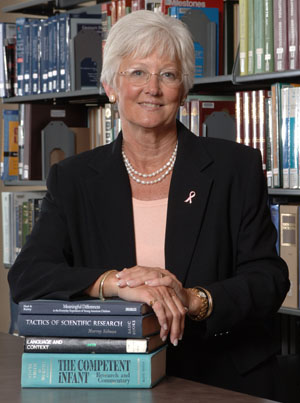As I sit down to write this, and look back over 13 years of research in the DAHS, two old advertising tag-lines keep popping into my head: “You’ve come a long way, Baby!” and “You made it the old fashioned way, you earned it!”

Looking Back
When I arrived in August 2000, we had no dedicated research support personnel; we had 14 faculty engaged in some level of funded research or training, and annual expenditures on grants or contracts totaling less than $1.4 million, of which less than half came from federal agencies, and which generated a total of only $58,616 in F&A funds for the University, including just $8,792 for the department.
In contrast, today we have a full-time Grants and Contracts Specialist, an Associate Chair for Research, a very proactive Research Advisory Committee, a half-time Research Coordinator/Grant Editor, and a part-time Research Systems Analyst. And, starting in August, we will have 2.0 FTE dedicated research design and analysis faculty members available to collaborate on faculty research, assist in teaching graduate level research courses, and provide professional development seminars for our faculty.
We have 34 active, externally funded projects this year, plus another 3 internally funded projects; 35 faculty receive salary support on funded projects. In terms of dollars, our annual direct cost expenditures for the fiscal year were approximately $4.5 million. The total award value of currently funded DAHS grants is $18.2 million, generating more than $3.5 million in F&A return for the University. Yes, we have come a long way in 13 years! And, this growth is directly attributable to the hard work of our faculty and their collective commitment to developing a strong research culture and infrastructure for our department.
Looking Ahead
Our progress over the past 13 years has put the DAHS on a trajectory which promises even greater growth and achievements over the next 10 years. As I look ahead for this department, I see a number of significant opportunities (and/or challenges, depending on how we choose to look at them). Let me just list a few of these:
Need and opportunities to diversify funding sources: In recent years, about 80% of our external funding has come from two federal agencies: the NIH and the U.S. Department of Education (Rehabilitation Services). With federal funding increasingly at risk, we must take advantage of opportunities to cultivate other funding sources, including the Department of Defense and the Veterans’ Administration, as well as non-governmental organizations and foundations, and private industry. We already have some experience with these other funding sources, and I see growing opportunities for us to develop these further, including new faculty recruitments, new interdisciplinary collaborations, and expanding interactions with the military community here in N.C.
Need and opportunities to expand collaborative networks: One of the clear directions coming out of our ongoing strategic planning is the need, and opportunity, for our faculty to develop new interdisciplinary, collaborative relationships – not only across our divisions, but critically, across the School of Medicine, and the University. Again, we can already point to several productive collaborations involving DAHS faculty and colleagues from other departments and schools. A couple of obvious areas ripe for further collaboration would be with faculty in the School of Public Health who focus on health care reform and new models of delivering health care; and with the Sheps Center, with its focus on the health care workforce, including the Allied Health disciplines. Similarly, there would seem to be many opportunities for collaboration with faculty in the School of Nursing, with research interests in clinical care across the lifespan, from the NICU through gerontology and hospice care. An expansion of our collaborative networks will also open doors to new funding sources, including the CDC, HRSA, and the Institute of Nursing.
Need and opportunities for more pre- and post-doctoral training grants: Over the past 13 years, we have seen the growth of our relatively new PhD programs, and of our faculty research. This growth creates the opportunity for development of new, pre- and post-doctoral interdisciplinary training grants focusing on areas where we have established research strength, including developmental disabilities in children and youth, acquired neurological disabilities (TBI, stroke, SCI), and geriatric services related to injury prevention, aging-in-place, and coordinated care. The benefits of research training grants are many, including the recruitment and retention of top students for our PhD programs, the preparation of desperately needed future faculty for our disciplines, and the introduction of new junior colleagues who will support, extend, and stimulate the programs of research conducted by our faculty. The old truism, “nothing succeeds like success,” certainly applies here!
New faculty colleagues: Finally, in response to faculty turnover, as well as some new funding, we have recruited nine new faculty members who will be joining us in August. These new colleagues will bring a variety of research experience, research interests, and methodological strengths to our department. (See profiles on page 6).
And, of course, the coming year will bring a new Chair to the Department, who will then work with our faculty to recruit a new Division Director for Physical Therapy. These new members of the DAHS leadership team will bring additional research expertise and interests to the DAHS. The future looks bright, indeed!
-By Dr. Lee McLean
